Garab Dorje (Wylie: dga’ rab rdo rje) is a seminal figure in Tibetan Buddhism, and is renowned as the first human teacher of Dzogchen – the Great Perfection of Ati Yoga. His life and teachings have profoundly shaped the Dzogchen tradition in particular and more widely the Nyingma school of Tibetan Buddhism.
The legend of his life and teaching is found in multiple sources in the Tibetan canon. As we might expect, there are multiple versions of the accounts, which differ considerably in details.
Garab Dorje is said to have lived in the land of Oddiyana (Uddiyana) most often believed by modern scholars to be in the Swat Valley, Pakistan. Perhaps more broadly he is associated North East into Gilgit and Karakorams or North West into modern day Afghanistan. This is a region which has been rich in spiritual legends and spiritual traditions.
According to the Dzogchen tradition itself, he was born between 200 BCE and 50 CE – though that makes it impossibly early to tie in with other aspects of his story, such as passing his teachings on to Manjushrimitra. The scholarly consensus therefore is that he was born around 665 CE.
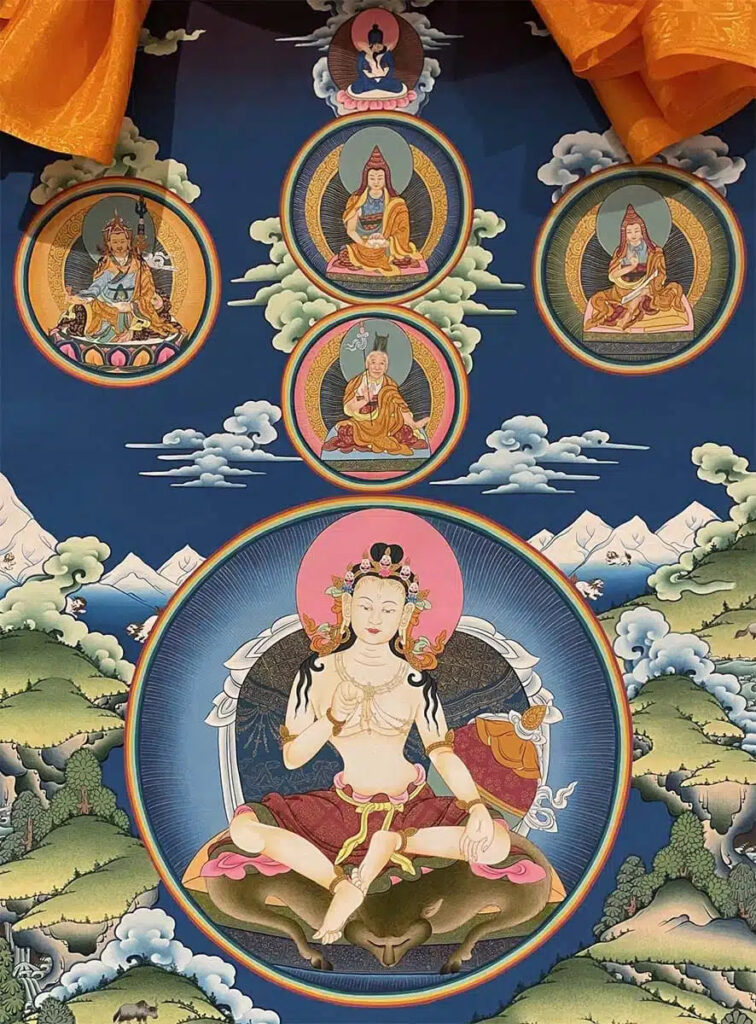
Miraculous conception and birth
Garab Dorje’s birth is surrounded by legend and symbolic narrative. His mother, Sudharmā (Kudharma) was the the daughter of King Uparāja and his consort Abhasvaravati. Sudharma became very devoted to the Dharma, and so became a nun. She took refuge in a retreat hut in the middle of a beautiful lake; (the symbolism of the middle of a lake resonates with that of Padmasambhava’s story). She was accompanied by a servant girl called Sukhakurunavati.
One night Sudharma had a particularly intense dream. A white divine figure or man held a crystal wand, and he had a crystal vase resting on his head. The vase had the letters ‘Om Ah Hung Svaha’ sealing the vessel with the empowerment of the five Buddha families.
He then touched Sudharma three times on the head with the crystal wand, and placed the crystal vessel on her head. Rays of pure light emanated from the vase, enabling her to see in all dimensions at the same time. This act led to her immaculate conception.
Once awake she shared this dream with Sukhakurunavati, the servant girl, who then revealed herself to be a Dakini! Sukhakurunavati then prophesised that Sudharma would give birth to a very special baby who would be an emanation of the wisdom of the Buddha’s.
As Sudharma was a nun she felt intense shame on giving birth to he child. As a result she rejected him. She left him in a cinder or ash pit for a number of days. Divine light and music emanated from the pit, revealing his divine origins. At this point she relented and took care of the child.
Child prodigy
Despite never formally receiving teachings, as a very young child he was able to speak and expound the Dharma. This including reciting the Dzogchen tantras, Garab Dorje was recognized for his exceptional wisdom. He was around six or seven years old when he began to really attract attention for his profound understanding of the Dharma.
Despite his young age, Garab Dorje had already been chanting the teaching known as ‘Dorje Sempa Namkha Che‘, which challenged conventional Buddhist views on cause and effect—a core principle in Buddhist philosophy. The Dzogchen position on cause and effect has remained contentious in non-Dzogchen circles to this day.
At the age of seven he asked Sudharma if he could visit the King Uparāja’s palace and teach the priests and panditas who acted as the King’s advisors in the royal palace. Of course the King was shocked at his presumption, but somehow he relented and invited him to meet with them.
By that time his fame had spread to India, prompting scholars from Nalanda University, including the renowned Manjushrimitra to travel to Oddiyana to meet this extraordinary boy. They joined the resident panditas at the royal court.
The Nalanda university scholars were initially highly skeptical of Garab Dorje’s abilities. He debated the 500 panditas and scholars (including Manjushrimitra). The Dorje Sempa Namkha Che played a key role in this debate. So brilliant was his teaching that he emerged victorious in debate, and they all paid homage to him. He earned the name Prajnabhava, or Wisdom Being. This is the Sanskrit for the name we now know him by in Tibetan – Garab Dorje.
Manjushrimitra, recognizing the profound wisdom in Garab Dorje’s words, admitted his mistake in doubting him and sought guidance on how to rectify his previous misconceptions. This event marked the beginning of his fame across India as a profound spiritual teacher. It’s worth adding that in some accounts Manjushrimitra wasn’t in that original debate, and come to meet Garab Dorje many years later.
Practice and retreat
It is said that he then entered intensive retreat for three decades. One legend of this time tells of how a local non-Buddhist king became fearful of Garab Dorje’s presence nearby, and so sent a couple of assassin’s to kill him. Apparently in response to this he walked along a path that took him up between the clouds. At this the King saw the error of his ways and become devoted to Garab Dorje.
Another tale tells of Vajrasattva appearing to him in a blaze of light, who pointed directly to the nature of his mind, and told him to record the Dzogchen Tantras – in some accounts this was Vajrapani. To do so Garab Dorje had to travel to Mount Malaya, where he met with a number of Dakinis. They helped him with his task of receiving and committing the Tantras to writing, as Vajrasattva had permitted and directed.
As his wisdom had developed strongly by now he travelled south to a blood-soaked cremation ground in Sitavana, North East of Bodhgaya. There he gave Dharma teachings to a band of cannibalistic wrathful Dakinis. It is said that many hundreds of thousands of Dakinis attained the Rainbow Body.
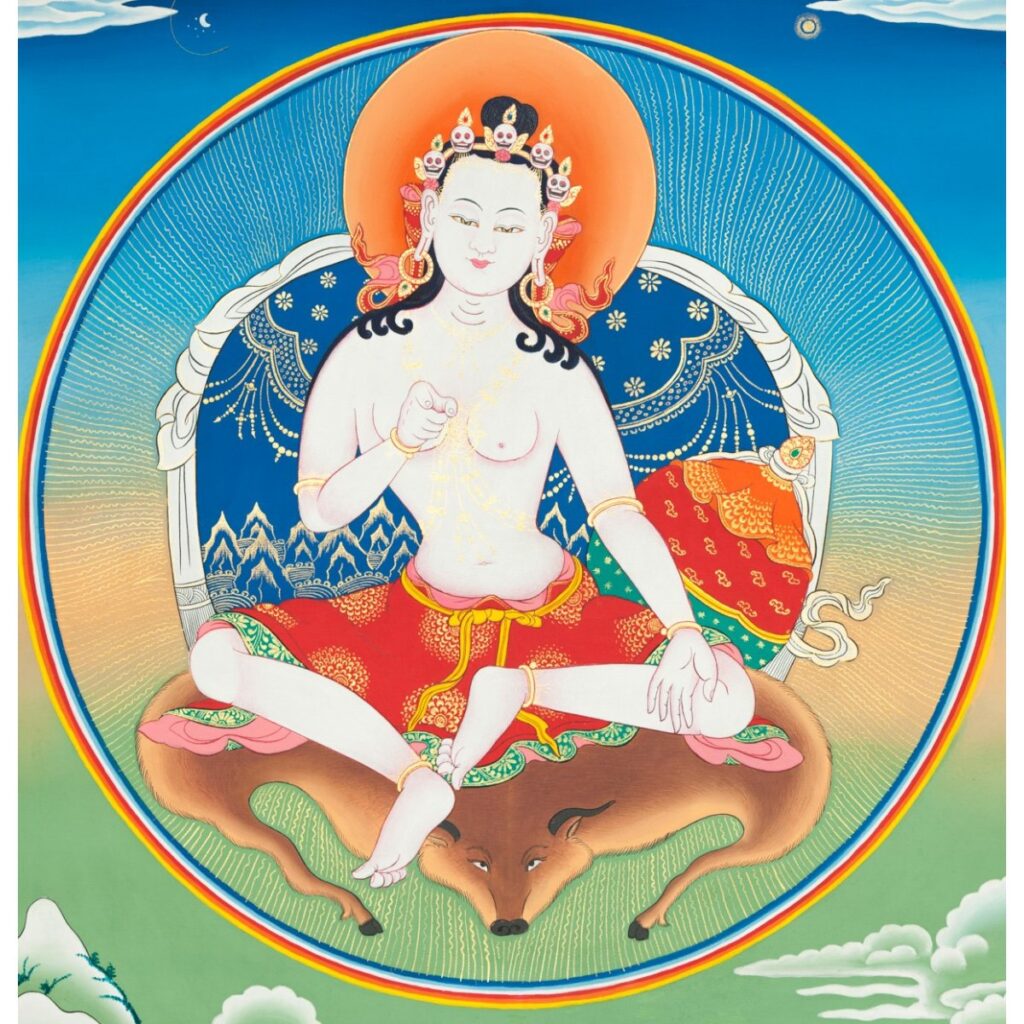
Transmission of teachings
The biographies tell of Garab Dorje receiving the complete direct transmission of Sutra, Tantra, and Dzogchen teachings from non-human teachers such as Vajrasattva, the embodiment of the Sambhogakaya realm, and who is a symbol of this pristine awareness, empty yet luminous.
He became the first human Vidyadhara in the Dzogchen lineage. He spent his life propagating these teachings, which emphasize the innate purity and completeness of mind’s true nature.
His most famous student was indeed Mañjuśrīmitra to whom he passed on the heart essence of Dzogchen. Mañjuśrīmitra’s presence at the debate had marked the beginning of his journey as Garab Dorje’s foremost disciple.
Parinirvana
Garab Dorje is said to have died at the source of the Danatika river. At his parinirvana, Garab Dorje performed an extraordinary act: he ascended into the sky and dissolved into rainbow light. In response Manjushrimitra being overcome and cried out with a plea for guidance. Garab Dorje then reappeared briefly within a mass of light and with the sound of thunderclaps. He manifested a small golden casket which descended into the palm of his hand, containing the essential Dzogchen teaching known as ‘The Three Words that Strike to the Heart‘, also known as ‘The Three Statements of Garab Dorje‘ – Tsik Sum Nedek in Tibetan. They are said to have been written in blue malachite on a leaf. This act ensured ensured the preservation and transmission of the fundamental Dzogchen teachings.
Teachings
Garab Dorje is most famous for his ‘Three Words that Strike to the Heart,’ which guide practitioners to recognize mind’s nature directly and how to stabilise this realisation. This teaching forms the essence of Dzogchen practice and is sparsely beautiful and lucid in clarity:
- Direct introduction to one’s own nature
- Not remaining in doubt concerning this unique state
- Continuing to remain in this state
I have written an extensive guide to the Three Statements of Garab Dorje on this blog. This teaching continues to be fundamental to Dzogchen practitioners to this day, peerlessly steering them to realisation and liberation.
Direct Introduction to Rigpa
Rigpa, the nature of mind, is typically introduced by a teacher who points it out through their words, actions, and being. Once you recognize it, you see that mind is fundamentally empty yet luminous. It’s utterly groundless, but also has a fundamental wakefulness. You cannot say it’s one or the other. It’s both, yet this emptiness and knowingness are inseparable, forming a nondual nature.
Decide Upon One Thing
After recognizing Rigpa, you simply rest in that recognition without trying to change or cultivate anything. You do not attempt to fabricate anything at all. Allow appearances to arise and cease while maintaining awareness of empty luminosity. The more you relax into this state, the more it becomes your default mode of experience. Deep in your bones you recognise that this is the most important recognition.
Confidence in Liberation
As you practice resting in Rigpa, you develop confidence that it is the fundamental nature of reality. This recognition becomes the key to both meditation and daily life, allowing all experiences to self-arise and self-liberate as expressions of luminous emptiness. You know there is nothing else to do. Stay with Rigpa and allow all that arises and ceases to do so within Rigpa.
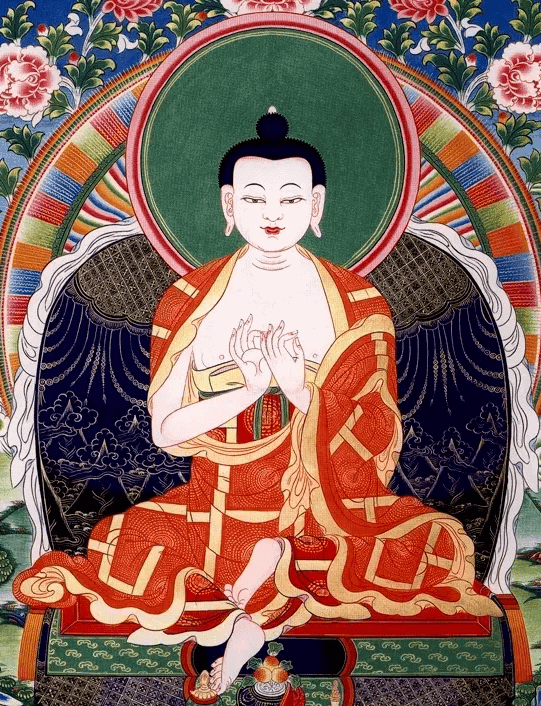
Legacy
Garab Dorje is the root Guru of the Dzogchen teachings. His influence remains absolutely central, and extends forward through his chief disciple, Manjushrimitra, to whom he passed the profound transmission of Dzogchen. The lineage continued through other great masters, including Padmasambhava, who is credited with bringing Buddhism to Tibet. We will share biographies of these masters over time.
What were the core elements of his legacy? Well, as noted he was said to be the first human teacher of the tradition. And his Three Statements are so foundational for Dzogchen – I’m not sure there is another pith teaching like this which has had such an impact. They are utterly core to the tradition. He is widely accepted as a Nirmanakaya form.
Garab Dorje beyond his direct teaching
There isn’t a huge textual legacy beyond the Three Statements, but the Seventeen Tantras of Dzogchen are traditionally said to have been revealed to Garab Dorje. These form the Tantric basic for the Dzogchen tradition. Modern scholars, however, suggest that they show signs of being compiled by multiple authors over a long period. Further, he is said to have spontaneously recited the Dorje Sempa Namkha Che whilst a child.
One additional area where Garab Dorje is prominent is in the range of ritual devotional practices which invoke him. There are Guru Yoga practices for Garab Dorje, where he is visualised either above the meditators head or in front of them as a source of blessings and wisdom. He’s further invoked in the lineage prayers of the various Dzogchen traditions.
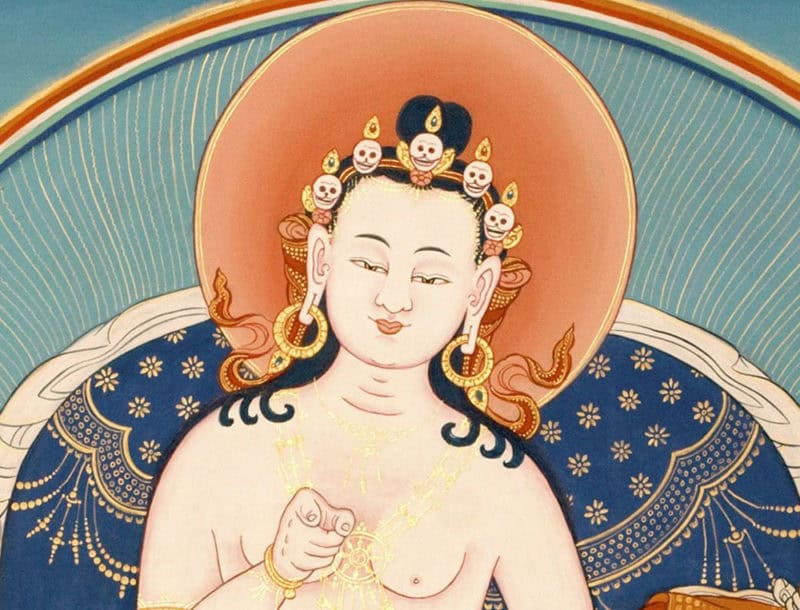
Garab Dorje sits in my heart
For myself his ‘Three Words that Strike to the Heart‘ is the central framework for my practice, should I choose to call it practice. All the rest is elaboration. This is the core. He points directly to it. Then points you to how to hold that which has been pointed to. You could say that this which is pointed to comes to hold itself. Be itself.
As they say ‘sometimes the teaching finds you, rather than you finding the teaching’. That’s exactly how I would describe it in this case. How blessed I am!
The Bon teacher Tapihritsa
Finally, I just want to share one further image, which may be a bit surprising, as not of Garab Dorje himself? I particularly love this image of Tapihritsa, from the Bon tradition.
I sometimes find myself drawn to seeing Garab Dorje in this form, appearing Samantabhadra-like. The unadorned pristine purity of his form exactly matches the unadorned pristine purity of the core Dzogchen teaching from Garab Dorje:
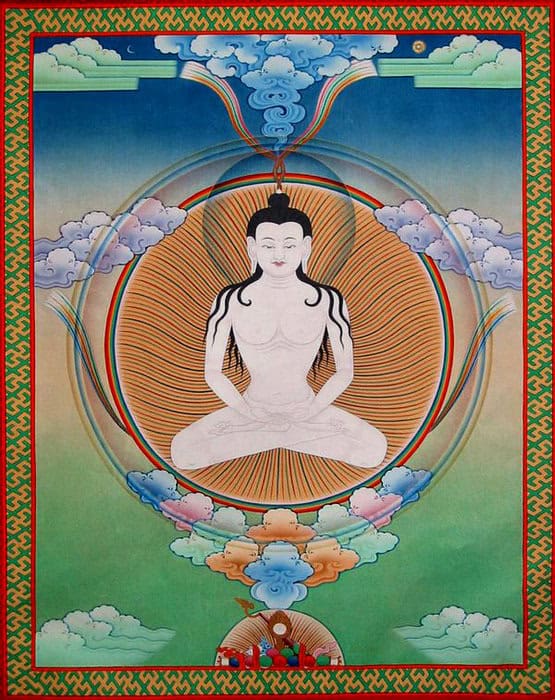

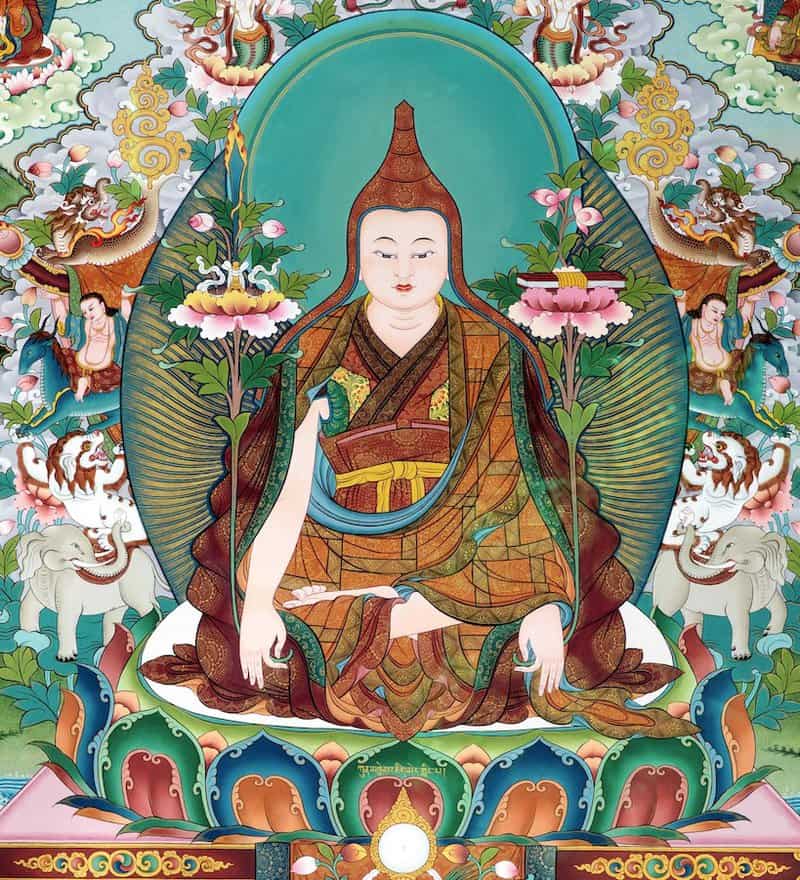
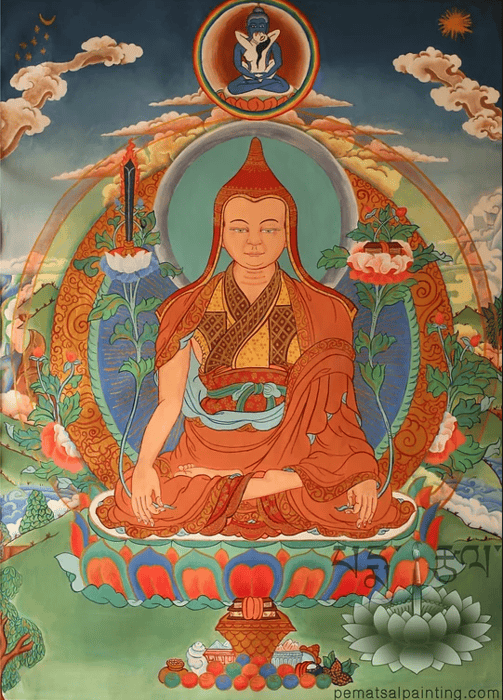
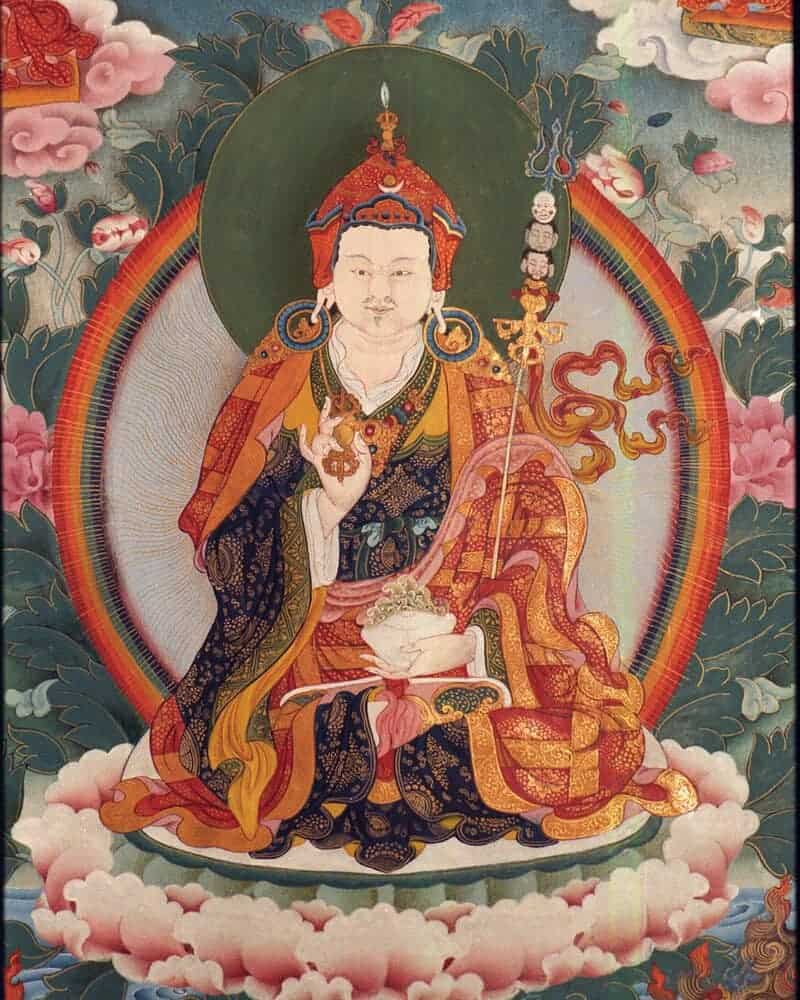
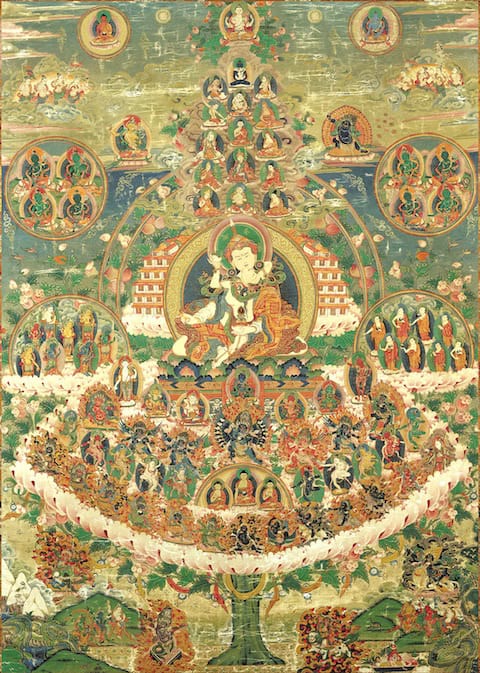
Great reading about one of my teachers. Thank you for sharing such wonderful knowledge! Really how can one ever get enough of these great wisdom beings?
Thanks Kent. How beautiful that you found a connection here with Garab Dorje. How very beautiful indeed! We are indeed blessed in this lifetime.
Hello,
Is there any historical guru that is considered a direct emanation of Garab Dorje? Great article!
Thank you
Thanks Scott for this, that’s really kind.
Yes there is. Manjushrimitra is often described as a ‘mind emanation’ of Garab Dorje. This is really interesting given they were contemporaries, and Manjushrimitra received the 3 Words that Strike the Vital Point from Garab Dorje. I understand that there are references to these in both the Zabmo Yangtik lineage accounts, and in some Namthar of Vimalamitra.
In some treasure texts Padmasambhava is called a Nirmanakaya emanation of Garab Dorje’s wisdom mind.
Longchenpa is sometimes described as a direct emanation of Garab Dorje’s wisdom mind. Reference the Lotus Garland of Supreme Perfection.
Nyoshul Lungtok Tenpai Nyima is regarded as an emanation of Garab Dorje.
These are not Tulkus but more the enlightened presence of Garab Dorje manifesting to meet the needs to beings.